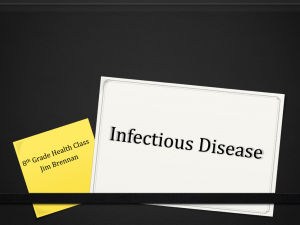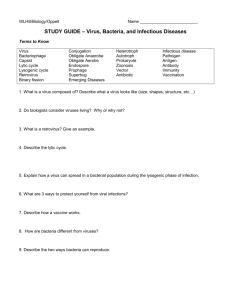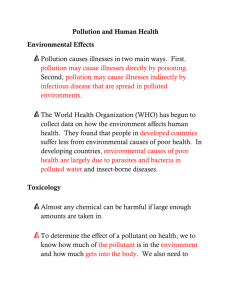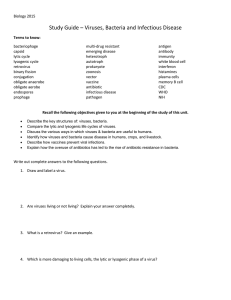CHAPTER 20 The Environment and Human Health Section 2
advertisement
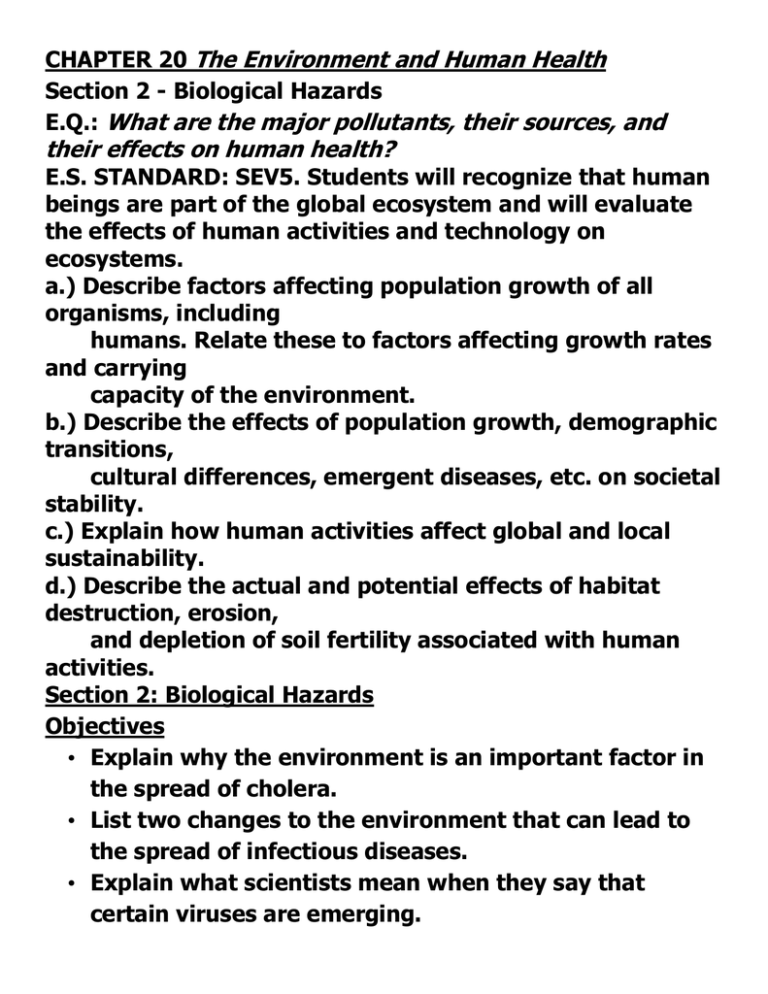
CHAPTER 20 The Environment and Human Health Section 2 - Biological Hazards E.Q.: What are the major pollutants, their sources, and their effects on human health? E.S. STANDARD: SEV5. Students will recognize that human beings are part of the global ecosystem and will evaluate the effects of human activities and technology on ecosystems. a.) Describe factors affecting population growth of all organisms, including humans. Relate these to factors affecting growth rates and carrying capacity of the environment. b.) Describe the effects of population growth, demographic transitions, cultural differences, emergent diseases, etc. on societal stability. c.) Explain how human activities affect global and local sustainability. d.) Describe the actual and potential effects of habitat destruction, erosion, and depletion of soil fertility associated with human activities. Section 2: Biological Hazards Objectives • Explain why the environment is an important factor in the spread of cholera. • List two changes to the environment that can lead to the spread of infectious diseases. • Explain what scientists mean when they say that certain viruses are emerging. The Environment’s Role in Disease • Some of the damage to human health is not caused by toxic chemicals but by organisms that carry disease. • Infectious diseases are caused by pathogens, a virus, microorganism, or other substance that causes disease. • Some of these diseases are spread from person to person through the air. Others are spread by water that contains the pathogen. • Other disease are transmitted by a secondary host, such as a mosquito. • A host an organism from which a parasite takes food and shelter. • The table on the following slide lists the most deadly infectious diseases worldwide. The Environment’s Role in Disease Waterborne Disease • Pathogens can transfer diseases directly to humans through water, or organisms that carry the pathogens can transfer them to humans. • A vector is an intermediate host that transfers a pathogen or a parasite to another organism. • Widespread construction of irrigation canals and dam increase habitats for vectors, such as mosquitoes. • These organisms are intermediate hosts that transfer the pathogen or parasite to people. Cholera • Nearly three-fourths of infectious disease are transmitted through water. • The deadliest waterborne diseases, such as those that cause cholera and dysentery, come from drinking water polluted by human feces. • These diseases cause the body to lose water and become dehydrated, and they cause most of the infant mortality around the world Malaria • Malaria was once the world’s leading cause of death. • Malaria is caused by parasitic protists and is transmitted by a bite from female mosquitoes of many species. • No effective vaccine for malaria exists, but preventative measures are used to control mosquitoes. Antibiotic Resistance • By altering the environment, we make it more suitable for pathogens to live and reproduce. • Our actions cause pathogens to evolve resistance to antibiotics that are used to kill them. • In 1979, 6% of European strains of pneumonia bacteria were resistant to antibiotics. Ten years later, 44% of the strains were resistant. Malaria on the March • Malaria was common in the United States and Europe before the days of mosquito control. Now it is most common in tropical countries. • Historically, malaria was controlled by draining marshes and rice paddies and by spraying with pesticides. • Since the 1970s, however, mosquitoes have evolved resistance to most pesticides. • Currently, mosquitoes are controlled by spreading growth regulators that prevent mosquito larvae from maturing into adults or that sterilize the female mosquitoes • The mosquitoes that transmit malaria are found in the warmer parts of the world. • Thus it is thought that global warming could spread malaria to different parts of the world. • The following slide shows the areas into which malaria might spread under specific global warming conditions. Emerging Viruses • In recent years, medical scientists have been focusing on previously unknown viruses. • Examples of these “emerging viruses” include the hanta virus, the ebola virus, the West Nile virus, and the HIV, which causes AIDS. • Most viral diseases spread directly from one person to another. • Often, the virus invades the body through a cut or through mucus membranes. • We do not have many effective drugs to treat viral diseases. • Our main defense against viral diseases is vaccination. • However, vaccines are virus specific and viruses evolve rapidly. • New vaccines must be developed when a new strain of a viral pathogen evolves. Cross-Species Transfer • Lately, there has been an increasing number of pathogens that have made a cross-species transfer, or have moved from one species to another. • These pathogens have lived for centuries in some species of wild animals and have often done little damage. • When the pathogens invade humans, the pathogens cause serious diseases. For example West Nile virus and HIV fall into this category. • Some ecologists fear that cross-species transfer of diseases will be more common with continued destruction of habitats and of the environment.

